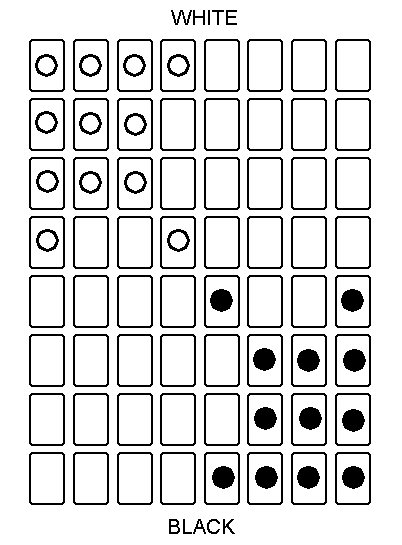Koper
Contributed by James Walsh
To play, you'll need a standard deck of 52 cards, without jokers, and the 24 checkers from a checkers (draughts) set or twelve coins of each of two denominations. This is a game for two players.
One player assembles the board by placing the cards face up in an 8 x 8 grid, leaving 12 empty spaces, the cards and empty spaces being considered spaces of the game board. (If the spaces include the whole of one side or end of the board, the player setting up the board must specify where the edge of the board is meant to be.) The other player chooses from which end of the board he wishes to start. (The board is always placed lengthways between the players.) Each player places his 12 checkers in what is from his perspective the lower right corner of the board in the following configuration.

The player who assembled the board makes the first move. Moves are as in Halma: one checker is moved one space in any direction or jumped in any direction over any number of friendly or opposing pieces. Jumped pieces are not removed from the board. Only one checker may occupy a space at any given time. A turn consists of each player making one move.
After every third turn (three moves by each player), each player forms a five-card poker hand from among the cards covered by his checkers. The player who moved second chooses which of his checkers to use and announces his hand first. Hands are ranked as is usual in poker. The player with the losing hand removes one of his checkers from the board. In case of a tie, neither player removes a checker.
Each player can use a given hand only once per game. Hands are considered distinct only if they are announced differently. The announcements are made in a standard format as follows:
| Straight Flush: | Suit and rank of top card |
| Four of a Kind: | Rank of quad |
| Full House: | Ranks of triplet and pair |
| Flush: | Suit and rank of top card |
| Straight: | Rank of top card |
| Three of a Kind: | Rank of triplet |
| Two Pairs: | Ranks of both pairs |
| Pair: | Rank of pair |
| High Card: | Rank of top card |
For example, a king-high flush in spades is a single hand regardless of what the lesser cards are, and four tens is a single hand no matter what the fifth card is.
Note that if you have fewer than five checkers on cards, the remainder being in spaces, you cannot announce a hand. If only one player is able to announce a hand the other player loses a checker. If neither is able to announce a hand, it is a tie and no checker is removed.
Example: A player has six checkers, standing on ![]() K
K ![]() K
K ![]() K
K ![]() K
K ![]() 9
9 ![]() 7 he can announce either four kings or three kings, depending which checkers are used. If he has already used both those announcements, he cannot announce a hand, and will lose a checker unless his opponent is also unable to announce a hand.
7 he can announce either four kings or three kings, depending which checkers are used. If he has already used both those announcements, he cannot announce a hand, and will lose a checker unless his opponent is also unable to announce a hand.
Note that having chosen your five checkers, you can only announce the exact hand made by those five cards. So in the example above you cannot announce a pair kings, because all your possible hands contain at least three kings. If your checkers are on A, Q, Q, 10, 9, 7, 5, 4 you can announce a pair of queens, or ace high, queen high or ten high, but not nine high because all your possible hands have a card higher than a 9.
Play continues until one player has only four checkers remaining on the board, at which time the other player wins.